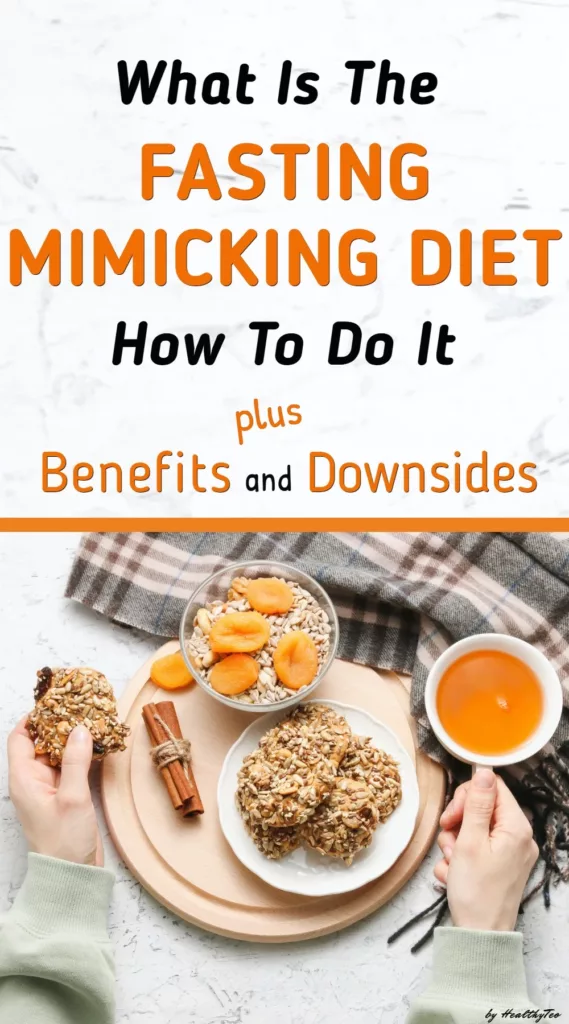The Fasting Mimicking Diet – What to eat plus potential benefits and downsides
The Fasting mimicking Diet is a 5-day dietary protocol that is different from any other type of intermittent fasting. This way of fasting is not for everyone.
In this article, we will show you the basics of the Fasting Mimicking Diet (FMD), what to eat on this 5-day diet, plus the potential benefits, and side effects of following this eating protocol.
To start let’s see what is the Fasting Mimicking Diet and how it works!
This post may contain affiliate links, which means we may receive a small commission, at no cost to you, if you make a purchase through a link. For more information, please see our disclosure.
What is a Fasting Mimicking Diet?
The Fasting Mimicking Diet is a type of modified fasting where instead of abstaining from food completely like a traditional fast, you consume small amounts of food.
This is a reduced-calorie diet with a specific macro and micro-nutrient breakdown that makes your body think it’s fasting while still allowing you to consume reduced amounts of foods.
A fast-mimicking diet was designed by Dr. Valter Longo and his team at the Longevity Institute at the University of Southern California.
Dr. Lango and his team after 25 years of research found that the body can mimic a fasting state with all the benefits that come with it, while still being nourished by food.
Dr. Longo sought to replicate the benefits of fasting while still providing the body with nutrition.
The Fasting Mimicking Diet or “fast-mimicking” is a type of intermittent fasting but very different from other traditional types, such as 16/8 intermittent fasting.
How Fasting Mimicking Works
The Fasting Mimicking Diet lasts for 5 days and the typically recommended caloric intake throughout the 5-day period is as follows:
- On day 1 you consume 1,100 calories. Of those calories, 11% should come from protein, 46% from fat, and 43% from carbohydrate.
- On days 2 through 5, you will consume just 725 calories per day, with a macronutrient breakdown of 9% protein, 44% fat and 47% carbohydrate.
During each of the five days, you should consume a minimum of 70 ounces (2 liters) of water daily.
Good to remember: The FMD is not designed to be a long-term diet plan.
This 5-day fast period should be performed anywhere from once a month for obese patients looking to lose weight for health reasons, and 2-3 times per year for health-conscious individuals looking to reap the potential longevity benefits.
If you want to try the Fasting Mimicking Diet and you’ve never fasted before or you are not sure is it good for you, it is best to consult with your health provider to determine if it is suitable for you.
What to eat on a fast mimicking diet?
The Fasting Mimicking Diet is based around simple, whole foods that are low in protein and sugars.
You can perform a DIY fasting-mimicking diet at home but Dr. Longo has a company called ProLon that sells specific FMD prepackaged meal kits.
The ProLon meal kits are low in carbs and protein but high in healthy fats like olives and flax. During the 5-day period, you will consume only what’s contained in the meal kit.
The ProLon meal kit is broken down into five individual boxes. A specific combination of food is provided for breakfast, lunch, dinner, and snacks depending on the day.
The food in these prepacked meals is plant-based, vegetarian, as well as gluten and lactose-free.
A 5-day ProLon Fasting Mimicking Diet kit contains:
Soup blends: A mix of soups including tomato soup, mushroom, minestrone, minestrone quinoa soup, butternut squash, spinach and white bean, black bean, and butternut squash quinoa.
Herbal tea: hibiscus tea, spearmint, and lemon-spearmint tea.
Nut bars: Made from honey, flax, macadamia nut butter, almond meal, and coconut.
Dark chocolate crisp bar: Made with cocoa powder, almonds, chocolate chips, and flax.
Kale crackers: Made from different ingredients including kale, herbs, pumpkin seeds, flax seeds, nutritional yeast.
Olives: This is a high-fat snack. One pack is for day 1, and 2 packs are provided on days 2-5.
Algal oil: This is a vegetarian-based supplement that provides dieters with 200 mg of omega-3 fatty acids and DHA.
NR-1: Powdered vegetable supplement that delivers a dose of minerals and vitamins.
L-Drink: This is a glycerol-based energy drink that is given from days 2 through 5 when your body starts to create energy from noncarbohydrate sources such as fats.
If you decide to do the Fasting Mimicking Diet via the ProLon program, you should only eat for 5 days only the food that is contained within the meal kit.
During these 5-days you should avoid consuming any other foods and beverages with two exceptions:
- You need to stay hydrated with plain water and decaffeinated teas during the 5-day fast.
- Soups can be flavored with lemon juice and fresh herbs
A typical day of eating on the Fasting Mimicking Diet looks like this:
- Breakfast: Nut bar and herbal tea
- Lunch: Soup with kale crackers
- Snack: A few olives
- Dinner: Bowl of soup
- Supplements: Glycerine drink with multivitamins plus DHA supplement
If you want to skip the ProLon meal kits and want to make soups and snacks by yourself here are homemade recipes for Fasting Mimicking Diet by California Center for Functional Medicine.
Can I drink coffee on Fasting Mimicking Diet?
This is the most common question when it comes to drinks on FAD. Coffee is not recommended on FAD but if you can’t go through your day without a coffee it is recommended to limit your coffee intake to just one cup per day.
Remember, only black coffee with no added sugar or any other sweetener!
How much does the ProLon meal kit cost?
The ProLon kit includes all of the dietary components needed for the 5-day plan. There are many options listed on their website, starting from $249 but there are many discounts so it is best to see their prices on the ProLon website.
Each ProLon plan also includes an optional complimentary coaching session with a health coach and the company also offers a customer assistance program to help low-income individuals access its products.
Potential benefits of a Fasting Mimicking Det
A fasting-mimicking diet is supported by research and according to science, an FMD can give you similar benefits to regular fasting.
Some people call this diet a longevity diet because it helps increase overall well-being.
May help with weight managment
A randomized controlled trial published in the Science Translational Medicine compared people who completed three cycles of the Fasting Mimicking Diet over three months to a control group.
The FMD group lost an average of 6 pounds (2.7 kg) and experienced greater reductions in belly fat than the control group.
Despite the fact that this study was led by the developer of the ProLon Fasting Mimicking Diet, there are many other studies that confirm the positive effects of fasting methods in promoting weight loss.
May support healthy brain and slow aging
One of the reasons why Dr. Longo developed the Fasting Mimicking Diet was to slow the aging process and risk of certain diseases.
The Fasting Mimicking Diet claims to slow the aging process through improved cell repair – a process called autophagy.
Autophagy is a process in which old, damaged cells are recycled to produce new, healthier ones.
Intermittent fasting has been shown to optimize autophagy, which may protect against mental decline and slow cellular aging.
There are many animal studies like this from 2010 which show that short-term food restriction led to a dramatic increase of autophagy in nerve cells.
Despite all animal studies, more human studies need to be carried out to fully understand how fasting may impact aging and disease risk.
May reduce cholesterol and blood sugar levels
The same study that we’ve mentioned before related to weight loss, showed that the Fasting Mimicking Diet group experienced a significant drop in cholesterol and blood sugar levels.
Blood sugar levels dropped in the normal range in participants who had high blood sugar at the start of the study. The cholesterol was also reduced by 20 mg/dl in those with high cholesterol levels.
The results of this study are promising however, more human studies are needed to determine the effects of FAD on blood sugar and cholesterol levels.
Other potential benefits of a Fasting Mimicking Diet
Potential downsides of FMD
There could be some potential downsides of following a Fasting Mimicking Diet and it is recommended to check with your doctor before starting with this diet, whether you purchase a ProLon plan or attempt to do it yourself.
One of the areas of concern is dehydration. You will be limiting the amount of food you take in which is a good source of fluid. So, it is important to follow the recommended fluid intake and be sure you’re drinking enough water.
Difficulty – Some people report feeling fatigued during the 5-days, while others can go about their normal life without any trouble. You should take some time and make a good plan before starting.
You should consider how the diet will impact your routine, and if is possible to schedule the protocol during a quiet week if is possible.
Medications – There is also a risk for possible adverse effects on individuals taking medications that may be affected by food and fluid or specific nutrient intakes.
Who should avoid the Fasting Mimicking Diet?
Fasting Mimicking Diet is not recommended for:
- Pregnant or breastfeeding women.
- People alergic to nuts, soy oats, celery or sesame.
- People who are underweight, have experienced protein deficiency, or are malnourished.
- People who have an active infection or are at risk of repetitive infection.
- People with dietary restrictions or a fever, cough, diarhea.
- People with a history of disordered eating.
- Anyone with medical condition – diabetes, hypertension, liver disease, kidney disease, or another cronic condition should consult a physician prior to starting this or any other new diet.
Difference between Fasting Mimicking Diet and Intermittent Fasting
Intermittent fasting and the Fasting Mimicking diet are not the same.
Intermittent fasting is an eating pattern that cycles between periods of eating and fasting. Or simply said there are periods of the day when no food is eaten.
There are different types of intermittent fasting depending on when you eat and fast, such as 16/8 intermittent fasting, the 5:2 diet, alternate-day fasting, the warrior diet.
The most common is the 16/8 model of IF, where a person fasts for 16 hours and eats during an 8-hour window.
The Fasting Mimicking Diet is different than any of the intermittent fasting methods. The FMD provides specific foods to promote health benefits and is not concerned with timing or windows of not food at all.
So, on intermittent fasting, you must follow the time windows of eating and fasting and you can eat anything you want during eating hours (almost anything).
On the other hand on Fasting Mimicking Diet there are specific foods that you should consume but there are no eating or fasting hours that you need to follow.

Final thoughts about the Fasting Mimicking Diet – Should you try it?
The Fasting Mimicking Diet may be a good way to reap all the benefits of fasting while still consuming a modest amount of calories.
This diet aims to provide the fasting benefits without common side effects of fasting such as fatigue, headaches, or weakness.
However, more research is needed to determine if it’s more effective than other well-researched intermittent fasting methods like the 16/8 intermittent fasting method.
You would also need to buy the meal kits which means that you need to spend some money or you can do it yourself by choosing the right foods, drinks, and supplements.
Doing FMD by yourself is not easy because you will need to calculate the exact amount of calories and the right portion of protein, carbs, and fat.
This is the reason why many people choose to take the prepackaged meal kit to follow the 5-day FMD.
This 5-day Fasting Mimicking Diet is not for everyone. If you are interested in trying this diet be sure to consult your doctor first.
Fasting is not appropriate for every person, so when you want to make a change in your diet always consult with your doctor!




